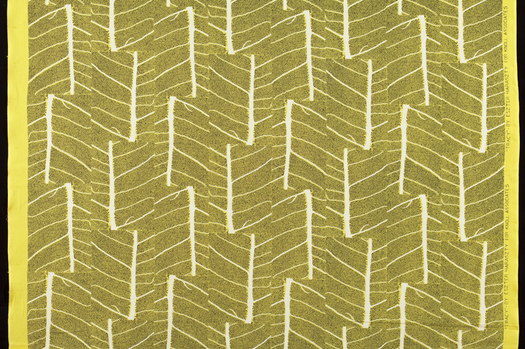
Eszter Haraszty. Tracy. Introduced 1952. Courtesy Bard Graduate Center.
It sometimes feels as if no aspect of American midcentury modern design has been left unconsidered, unexhibited, unreissued. But there is undiscovered territory. You’re sitting on it.Those are the opening lines of "High Fiber," my preview in this weekend's T Magazine of the upcoming exhibition. I have long loved the brilliant colors used in Knoll interiors, and this show brings many new names and new fabrics to light. Many of the textiles on display were found in attics, some of those the attics at very famous museums. When acquisitions of famous furniture came in, the bolts and scraps of upholstery were stored, awaiting rediscovery as design objects in and of themselves.
“Knoll Textiles, 1945-2010,” at the Bard Graduate Center in Manhattan from May 18 to July 31, flips the story line on the brand’s famous chairs (Womb, Tulip, Diamond, Platner) by focusing on the fabrics rather than the frames.

Evelyn Hill Anselevicius. Handwoven smaple ca. 1952. Philadelphia Museum of Art. Knoll samples at right (via The Moment).
Iit isn't just the fabrics that are undiscovered territory, but the women who made them. There are a number of famous names, like Swedish architect Sven Markelius, whose 1952 contribution to the Knoll line, Pythagoras, graces the United Nations. But we haven't heard much about Evelyn Hill Anselevicius, who moved from textile design of an extreme sort (see above) to a career as a weaver who was exhibited at the Philadelphia Museum of Art. The forthcoming catalog, from Yale University Press, includes new biographies for the designers (and textile department heads, like Suzanne Huguenin and Eszter Haraszty) shown in the exhibition, as well as an extensive company history.

Hella Jongerius. Borders. 2011. Maharam (via Design*Sponge).
The contemporary designer Evelyn Hill's handwovens made me think of is Hella Jongerius, who has been exploring some old-fashioned crafty techniques in her fabrics for Maharam. Her latest, Borders, feels beautiful, and riffs on the menswear woolens Florence Knoll used in the early years, plus folkloric themes (a la Alexander Girard, whose Herman Miller fabrics competed with Knoll Textiles) and Jongerius's own embroidered vases. All I miss is the color. Wouldn't this look great in purple, with yellow triangles and a red dotted line? Knoll's 1950s designers wouldn't have been so timid.
